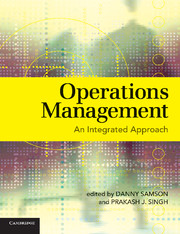Book contents
- Frontmatter
- Contents
- List of Contributors
- Preface
- Acknowledgements
- Part I Operations within Organisations – Building Blocks
- Part II Approaches to Understanding OM
- 5 Strategic Approach to Operations Management
- 6 Processes and Systems in Operations Management
- 7 Supply Chain or Network Approach to Operations Management
- Part III Moving Forward with OM – Creating Competitive Advantage
- Part IV Challenges and Opportunities in Operations
- Part V Case Studies
- Index
- References
5 - Strategic Approach to Operations Management
Published online by Cambridge University Press: 05 June 2012
- Frontmatter
- Contents
- List of Contributors
- Preface
- Acknowledgements
- Part I Operations within Organisations – Building Blocks
- Part II Approaches to Understanding OM
- 5 Strategic Approach to Operations Management
- 6 Processes and Systems in Operations Management
- 7 Supply Chain or Network Approach to Operations Management
- Part III Moving Forward with OM – Creating Competitive Advantage
- Part IV Challenges and Opportunities in Operations
- Part V Case Studies
- Index
- References
Summary
Learning objectives
After reading this chapter you should be able to:
understand and interpret the concept of operations as part of organisational strategy and related analytical perspectives
understand and interpret the notion of competitive advantage and the nature of generic competitive strategies pursued by organisations
understand and appreciate the strategic role of the operations function and its contribution to the sustainable competitive advantage of the organisation
understand and describe the role of competitive priorities in operationalising strategy
discuss the concept of trade-offs as applied to key decisions and actions regarding the operations structure and infrastructure of an organisation
demonstrate your ability to apply the conceptual understanding developed as above to support managerial decisions and actions.
Box 5.1: Management challenge: strategic operations options for Delta-tech
Delta-tech, a small privately owned company based in New South Wales (NSW), Australia, was founded in 1947 to supply speciality consumables to the local heavy manufacturing sector. Over the past ten years, after being bought by its current owner Ed Palmer, the company has grown from a small-scale maintenance service-provider/equipment and consumables supplier to a technology developer/small-scale manufacturer of equipment that exceeded the performance and quality standards of reputed international brands. It currently employs 22 staff (including Mr Palmer as MD and three other supervisory staff), with an annual sales revenue exceeding $5 million. Delta-tech is currently catering to a niche market segment within the heavy manufacturing and process industry in NSW and Queensland with limited exports, and operates from its Sydney facility. […]
- Type
- Chapter
- Information
- Operations ManagementAn Integrated Approach, pp. 123 - 160Publisher: Cambridge University PressPrint publication year: 2008



